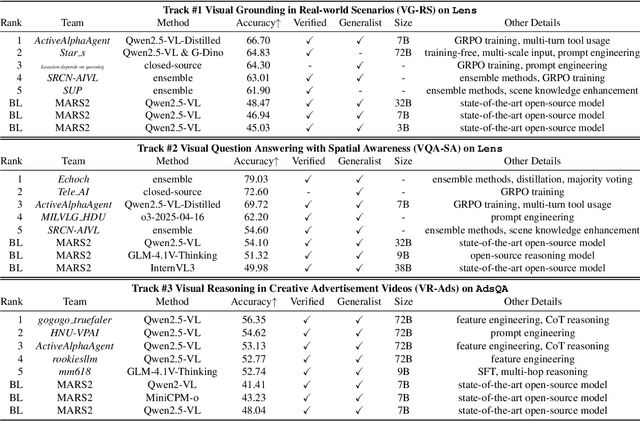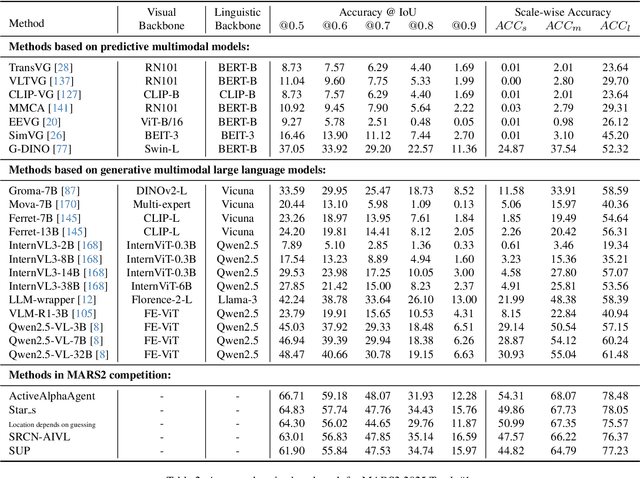Jirui Huang
MARS2 2025 Challenge on Multimodal Reasoning: Datasets, Methods, Results, Discussion, and Outlook
Sep 17, 2025



Abstract:This paper reviews the MARS2 2025 Challenge on Multimodal Reasoning. We aim to bring together different approaches in multimodal machine learning and LLMs via a large benchmark. We hope it better allows researchers to follow the state-of-the-art in this very dynamic area. Meanwhile, a growing number of testbeds have boosted the evolution of general-purpose large language models. Thus, this year's MARS2 focuses on real-world and specialized scenarios to broaden the multimodal reasoning applications of MLLMs. Our organizing team released two tailored datasets Lens and AdsQA as test sets, which support general reasoning in 12 daily scenarios and domain-specific reasoning in advertisement videos, respectively. We evaluated 40+ baselines that include both generalist MLLMs and task-specific models, and opened up three competition tracks, i.e., Visual Grounding in Real-world Scenarios (VG-RS), Visual Question Answering with Spatial Awareness (VQA-SA), and Visual Reasoning in Creative Advertisement Videos (VR-Ads). Finally, 76 teams from the renowned academic and industrial institutions have registered and 40+ valid submissions (out of 1200+) have been included in our ranking lists. Our datasets, code sets (40+ baselines and 15+ participants' methods), and rankings are publicly available on the MARS2 workshop website and our GitHub organization page https://github.com/mars2workshop/, where our updates and announcements of upcoming events will be continuously provided.
LENS: Multi-level Evaluation of Multimodal Reasoning with Large Language Models
May 21, 2025Abstract:Multimodal Large Language Models (MLLMs) have achieved significant advances in integrating visual and linguistic information, yet their ability to reason about complex and real-world scenarios remains limited. The existing benchmarks are usually constructed in the task-oriented manner without guarantee that different task samples come from the same data distribution, thus they often fall short in evaluating the synergistic effects of lower-level perceptual capabilities on higher-order reasoning. To lift this limitation, we contribute Lens, a multi-level benchmark with 3.4K contemporary images and 60K+ human-authored questions covering eight tasks and 12 daily scenarios, forming three progressive task tiers, i.e., perception, understanding, and reasoning. One feature is that each image is equipped with rich annotations for all tasks. Thus, this dataset intrinsically supports to evaluate MLLMs to handle image-invariable prompts, from basic perception to compositional reasoning. In addition, our images are manully collected from the social media, in which 53% were published later than Jan. 2025. We evaluate 15+ frontier MLLMs such as Qwen2.5-VL-72B, InternVL3-78B, GPT-4o and two reasoning models QVQ-72B-preview and Kimi-VL. These models are released later than Dec. 2024, and none of them achieve an accuracy greater than 60% in the reasoning tasks. Project page: https://github.com/Lens4MLLMs/lens. ICCV 2025 workshop page: https://lens4mllms.github.io/mars2-workshop-iccv2025/
LAMM-ViT: AI Face Detection via Layer-Aware Modulation of Region-Guided Attention
May 12, 2025Abstract:Detecting AI-synthetic faces presents a critical challenge: it is hard to capture consistent structural relationships between facial regions across diverse generation techniques. Current methods, which focus on specific artifacts rather than fundamental inconsistencies, often fail when confronted with novel generative models. To address this limitation, we introduce Layer-aware Mask Modulation Vision Transformer (LAMM-ViT), a Vision Transformer designed for robust facial forgery detection. This model integrates distinct Region-Guided Multi-Head Attention (RG-MHA) and Layer-aware Mask Modulation (LAMM) components within each layer. RG-MHA utilizes facial landmarks to create regional attention masks, guiding the model to scrutinize architectural inconsistencies across different facial areas. Crucially, the separate LAMM module dynamically generates layer-specific parameters, including mask weights and gating values, based on network context. These parameters then modulate the behavior of RG-MHA, enabling adaptive adjustment of regional focus across network depths. This architecture facilitates the capture of subtle, hierarchical forgery cues ubiquitous among diverse generation techniques, such as GANs and Diffusion Models. In cross-model generalization tests, LAMM-ViT demonstrates superior performance, achieving 94.09% mean ACC (a +5.45% improvement over SoTA) and 98.62% mean AP (a +3.09% improvement). These results demonstrate LAMM-ViT's exceptional ability to generalize and its potential for reliable deployment against evolving synthetic media threats.
 Add to Chrome
Add to Chrome Add to Firefox
Add to Firefox Add to Edge
Add to Edge